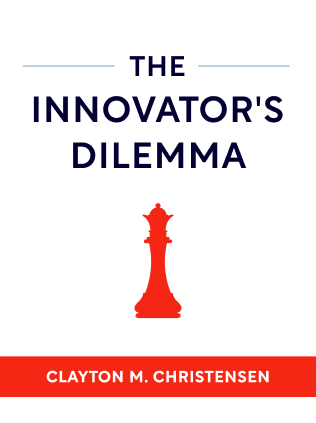

This article is an excerpt from the Shortform summary of "The Innovator's Dilemma" by Clayton M. Christensen. Shortform has the world's best summaries of books you should be reading.
Like this article? Sign up for a free trial here .
What innovation resources are essential to disrupt markets? How can innovation resources position a company for success?
Innovation resources are the capabilities, values, and culture that come together to help encourage or address disruption. An organization needs innovation resources to develop disruption capacity and respond to market disruptors.
Read more about innovation resources and how they work.
Innovation Resources at Established Firms
Established firms become successful by developing certain capabilities that help them to efficiently and profitably develop, market, and sell their goods or services. Each company’s capabilities are specific to its product and the value networks.
However, the same characteristics that define a company’s strengths in one context constitute weaknesses in another. In this way, a company’s capabilities and disabilities are two sides of the same coin.
Disruptive innovations require a different context—a different value network, cost structure, and production process—than existing products, which turns established companies’ capabilities into disabilities when confronting disruptive innovations.
Defining Innovation Capabilities
Innovation resources fall into three categories:
- Supplies, such as people, money, technology, knowledge, customers, and relationships with suppliers and distributors. When assessing a company’s capabilities, managers tend to focus primarily on resources.
- Processes, such as patterns of communication, coordination, and decision-making. Processes are the methods by which the company turns resources into output and ensures the goods or services are uniform.
- Values, which dictate how the company and its employees make prioritizing decisions. Values impact how every employee makes decisions, big and small—from how to manage their time to which new projects to take on.
Supplies
These are the easiest to remedy: You can hire new people, implement new training, bring in new technology, and raise more cash.
Established companies tend to have ample innovation resources. By comparison, entrants typically have few innovation resources, but its people resources—specifically founders, managers, and employees—often constitute their biggest capabilities. A startup’s people are so critical to its early success, that losing just one person can derail the company’s progress.
Processes
Processes ensure that everything from manufacturing to payroll operates in the same way every time, whether the employee performing the task is a new hire or a veteran. Processes can be explicitly defined protocols, or they can be implicitly understood.
Reliable processes are essential to a successful business, but they become major disabilities in the face of disruptions—since they’re meant to prevent change, processes themselves are very difficult to change.
While the visible processes relating to customer service, production, and development are important, the processes that most significantly determine a company’s capabilities or disabilities are the subtler processes that influence investment decision-making, such as market research methodology and how the company creates budgets and strategies. These background processes have a powerful effect on resource allocation, and they are especially difficult to change.
Entrants have the flexibility to develop processes that meet the needs of the disruptive technology and its market, unlike established firms, which are already entrenched in their established processes.
Values
Values inherently reflect a company’s cost structure, because they influence a company’s decision-making about what kind of projects to prioritize. If a company’s cost structure requires high gross margins, then its values influence investments in projects that promise large profits—which impede the company from investing in disruptive innovations.
Values influence which projects executives pursue, which tasks employees prioritize, and which products the sales team pushes. For example, if a company’s cost structure requires 40 percent profit margins to cover overhead costs, achieving those profit margins is a company value; executives reject projects expected to bring less than a 40 percent profit margin, employees prioritize tasks that support high-earning projects, and salespeople emphasize products that typically earn that profit margin.
Values are difficult to change on a whim, but, as a company grows, its values naturally evolve.
As a company targets higher-end customers, it often adds features to its products, which, in turn, adds to the company’s overhead cost. Increased overhead changes the cost structure, which changes the values. This value change constitutes a major disability in adopting disruptive technologies, because they offer low initial revenues.
Startups’ values naturally reflect the cost structure that the disruptive product and its market demand.
Processes + Values = Culture
While startups initially rely on their people resources to find success, over time, the young companies develop processes and values that maintain and improve upon that success.
Essentially, processes and values put certain aspects of the business on autopilot, so that the company has the capacity to use its resources to develop new products and updates. Startups that fail to shift their capabilities from their resources to processes and values burn out because they can’t keep up with new products and updates while maintaining a standard of quality.
When a company’s processes and values are so deeply ingrained in its managers and employees that they can carry out their jobs more or less autonomously, those processes and values have become the company’s culture. Effective company culture is key to maintaining quality and consistency as a company grows larger. However, when it comes to confronting disruptive innovations, disabilities that are rooted in a company’s culture are the most difficult to change.

———End of Preview———
Like what you just read? Read the rest of the world's best summary of Clayton M. Christensen's "The Innovator's Dilemma" at Shortform .
Here's what you'll find in our full The Innovator's Dilemma summary :
- Christensen's famous theory of disruptive innovation
- Why incumbent companies often ignore the disruptive threat, then move too slowly once the threat becomes obvious
- How you can disrupt entire industries yourself






